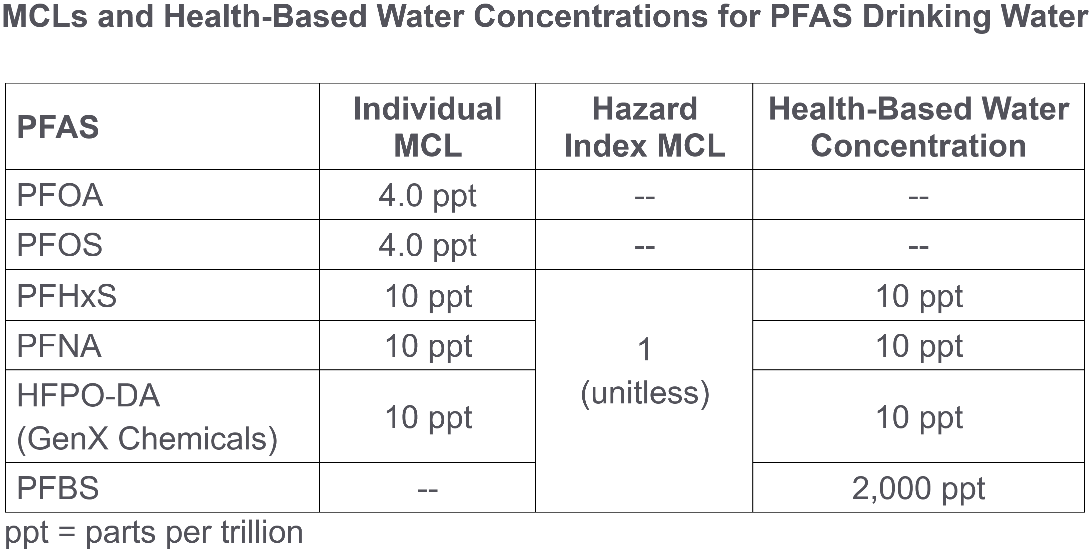
EPA Finalizes National Drinking Water Regulation for Six PFAS
On April 10, 2024, the U.S. Environmental Protection Agency (EPA) finalized a National Primary Drinking Water Regulation (NPDWR) for six PFAS:
- Perfluorooctanoic acid (PFOA)
- Perfluorooctane sulfonic acid (PFOS)
- Perfluorohexane sulfonic acid (PFHxS)
- Perfluorononanoic acid (PFNA)
- Hexafluoropropylene oxide dimer acid (HFPO-DA, commonly known as GenX chemicals)
- Perfluorobutane sulfonic acid (PFBS)
Individual Maximum Contaminant Level (MCL) values were finalized for five PFAS, and a Hazard Index MCL was finalized for four PFAS. Health-based water concentrations, which are used to calculate the Hazard Index, were also established for four PFAS. EPA developed a fact sheet detailing the process of calculating the Hazard Index, which evaluates the combined risk of PFHxS, PFNA, HFPO-DA, and PFBS. MCLs and health-based water concentrations are summarized in the table below.

A more detailed summary of the NPDWR is included in a Special Edition of our PFAS Technical Newsletter.
EPA Designates PFOA and PFOS as Hazardous Substances Under CERCLA
On April 19, 2024, EPA announced the designation of PFOA and PFOS, including their salts and structural isomers, as hazardous substances under the Comprehensive Environmental Response, Compensation, and Liability Act (CERCLA, or Superfund). A pre-publication version of the Final Rule is accessible on EPA’s website. CERCLA grants EPA the authority to designate a substance as hazardous, if a release of that substance into the environment “may present substantial danger to the public health or welfare or the environment.” Currently, there are approximately 800 CERCLA hazardous substances.
The designation of PFOS and PFOA as hazardous substances allows for EPA investigation and enforcement of these compounds at Superfund sites. Additionally, the designation impacts environmental due diligence and establishes release notification requirements. A more detailed summary describing the implications of this action is included in a Special Edition of our PFAS Technical Newsletter.
EPA Increases Funding by $1 Billion for PFAS Treatment
On April 10, 2024, EPA announced that nearly $1 billion would be added in 2024 to the funds available from the Bipartisan Infrastructure Law. This law was passed to help states and territories address emerging contaminants like PFAS in drinking water. The additional funds will be available through the Emerging Contaminants in Small or Disadvantaged Communities (EC-SDC) Grant that provides non-competitive loans for testing and treatment of emerging contaminants. The 2024 allotments for individual states and territories have been released and range from $9.5 to $82.9 million, based on the population, number of water systems, and emerging contaminant data within each state. In 2024, the EC-SDC grant funds can also be used for projects to address emerging contaminants in private drinking water wells.
EPA Releases Updated Interim Guidance on Destruction and Disposal of PFAS
On April 8, 2024, EPA released updated interim guidance on the disposal and destruction of PFAS and PFAS-containing materials. Methods for the destruction or disposal of solid, liquid, and gaseous PFAS and PFAS-containing materials in the interim guidance include landfilling, underground injection, and thermal treatment. The guidance addresses PFAS waste generated from industrial facilities manufacturing or using PFAS, spent or concentrated aqueous film forming foam (AFFF), PFAS-containing soil and biosolids, spent materials from wastewater treatment, landfill leachate containing PFAS, and non-consumer textiles treated with PFAS. Data gaps for PFAS destruction and disposal methods were also identified and discussed, and a framework for evaluating emerging destruction and disposal technologies was presented.
California Adopts PHGs for PFOA and PFOS in Drinking Water
On April 5, 2024, the California Office of Environmental Health Hazard Assessment (OEHHA) adopted Public Health Goals (PHGs) for PFOA and PFOS. PHGs are the level of a chemical contaminant found in drinking water that is not expected to pose a significant risk to human health. While PHGs are not regulatory standards, they are considered by the State Water Resources Control Board when establishing drinking water regulatory standards for California. A PHG of 0.007 parts per trillion (ppt) was established for PFOA based on kidney cancer in humans, and a PHG of 1 ppt was established for PFOS based on liver and pancreatic tumors in laboratory animals. Additionally, OEHHA identified noncancer health-protective drinking water concentrations of 3 ppt for PFOA and 2 ppt for PFOS.
Maine Phases Out Sale of Products Containing PFAS
On April 16, 2024, Governor Janet Mills of Maine signed into law a bill that phases out the sale of products containing intentionally added PFAS. The effective date of the ban depends on the product category and ranges from 2026 to 2040. The bill includes exemptions for products in electronics and semiconductors, firefighting foams, prosthetic and orthotic devices, motor vehicles, and equipment directly used in the manufacture or development of the products. Additionally, products containing “unavoidable” PFAS can continue to be sold, but the manufacturers must conduct product reporting. The reporting requirement does not apply to manufacturers with 100 or fewer employees.
Washington Bans Additional Food Packaging Products Containing PFAS
The Washington State Department of Ecology (Ecology) announced that, as of May 1, 2024, additional categories of plant fiber-based food packaging products with intentionally added PFAS will be banned in the state. The products identified include bags, sleeves, bowls, plates, trays, French fry cartons, food cups, and clamshell containers.
This action was conducted under a Washington law passed in 2018. The law, which went into effect in 2021, requires Ecology to annually evaluate plant fiber-based food packaging products with intentionally added PFAS and report on comparable replacement food packaging products that do not contain PFAS.
Questions?
If you have any questions or would like to discuss how PFAS may impact your business, please email pfas@geosyntec.com to be connected with a PFAS technical expert.
